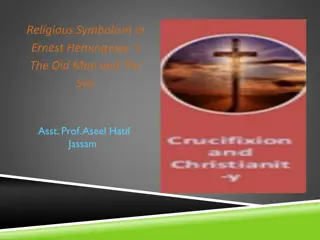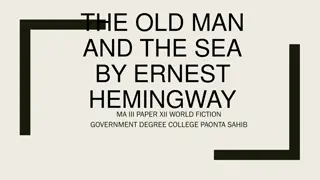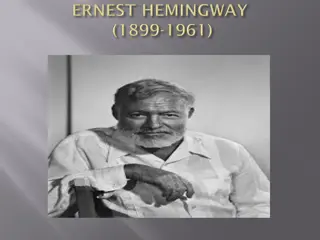Ernest Hemingway: Iconic Writer of the Lost Generation
Ernest Miller Hemingway, born in Oak Park, Illinois, was a prominent writer of the Lost Generation. His experiences in World War I influenced his writing style, marked by simplicity and objectivity. Moving to Paris, he mingled with Modernist artists and revolutionized American fiction. The Lost Generation, disillusioned by the war, sought meaning in a rapidly changing world, reflecting a shift from traditional values to modernist ideals.
Download Presentation

Please find below an Image/Link to download the presentation.
The content on the website is provided AS IS for your information and personal use only. It may not be sold, licensed, or shared on other websites without obtaining consent from the author.If you encounter any issues during the download, it is possible that the publisher has removed the file from their server.
You are allowed to download the files provided on this website for personal or commercial use, subject to the condition that they are used lawfully. All files are the property of their respective owners.
The content on the website is provided AS IS for your information and personal use only. It may not be sold, licensed, or shared on other websites without obtaining consent from the author.
E N D
Presentation Transcript
Lost Generation Writer Ernest Hemingway
Ernest Miller Hemingway was born in Oak Park, Illinois, an affluent suburb of Chicago, the son of a doctor who introduced his son to the outdoors. Hunting and fishing remained Hemingway's lifelong passions, and they appear in many of his stories and novels. Hemingway published a weekly column for his high school newspaper and contributed poems to the school magazine. Instead of attending college, he worked as a junior reporter for the Kansas City Star. This early experience in daily journalism, where simplicity, objectivity, and immediacy were required, affected his mature writing style.
Before America entered World War I, Hemingway, who was still in his teens, wanted to watch the fighting firsthand. He volunteered as a Red Cross ambulance driver after being repeatedly rejected for Allied military service due to a faulty eye. He served in Italy, and in 1918, he was critically injured in both legs by shrapnel while bringing supplies to front-line troops. Following a period of recuperation in Milan, which subsequently served as inspiration for his fictional works, Hemingway returned to his home town. However, he encountered challenges in readapting to his life before to the war.
Hemingway began writing fiction seriously again, but he was forced to work in journalism to support himself. After his first marriage in 1921, Hemingway and his young wife relocated to Paris, where he worked as a journalist for the Toronto Star. Hemingway slowly developed the short, accurate, and simple style that would change the direction of modern American fiction. He was influenced by both the classic authors he read with great care, like Chekhov and Tolstoy, and the Modernists he met in Paris, like Gertrude Stein and Ezra Pound.
With the rise of technological advancement and the prevailing effect of disillusionment after the First World War, the Modernism movement quickly spread, especially in the United States. During the 1920s, a group of artists, especially writers, had been deeply affected by the war and the disillusionment it caused, and they moved to Paris as expatriates. Coined as the Lost Generation, they represented a generation who had either been on the battlefronts or been affected by being a homefront civilian.
They represented a group within a generation who came out of age around the same period as World War I. They were considered lost in the sense that they had lost all their belief in old, traditional values, which in turn made them disoriented, aimless, and alienated. The inherited values of the pre-war era were no longer relevant to the post-war era. What was once considered to be courageous, nationalist, or patriotic, had no meaning after the war because of the massive scale of death and its impact.
The Lost Generation had a strong reaction against it, because after seeing death on a massive scale, what was left behind was nothing but the reality of pain and, for them, nothing could no longer overcome this reality of pain.
As a result, the Lost Generation tried new ways to cope with their new life in the post-war era, where they had lost all the things they had known. They drank heavily, they became increasingly hedonistic and materialistic. They became emotionally barren from all that pain. Besides that, they also tried new ways to experiment with their works of art, because the pre-war expressions had no longer any meaning in the post-war world. They needed new ways to express this new, lost reality which was full of alienation, loss, and disillusionment.
As one of the notable writers of the Lost Generation, Ernest Hemingway was one of the leading figures to create a new, distinctive style that was differentiated from the old, traditional, and elaborated style of pre-war Victorian prose.
Hemingway's famed literary style includes Ezra Pound's concept of the "Imagist" method, which requires "direct treatment of the 'thing" and "the use of no word that does not contribute to the total design. (Hemingway commented about Pound, He's teaching me to write, and I'm teaching him to box. ) Hemingway s creative work was first published in Three Stories and Ten Poems (1923) and In Our Time (1925).
Building his style by using short and simple sentences and paragraphs, what Hemingway achieved in his writings is to be able to get the most from the least. Known also as the Iceberg Theory, according to Hemingway, since the seven-eights of an iceberg hides under the water, the prose must be written according to this principle. The story should only be written in a way that only the narrative, plot, dialogue, and action should be seen by the reader
However, there must be more below the surface of the story, there must be a hidden side of thoughts, feelings, beliefs, fears, experiences, and motives. The subtext of the story must be hidden between the short and simple sentences. Also known as the Theory of Omission, which involves omitting important things to hide them below the surface, Hemingway argues in Death in the Afternoon, If a writer of prose knows enough about what he is writing about he may omit things that he knows and the reader, if the writer is writing truly enough, will have a feeling of those things as strongly as though the writer had stated them. The dignity of movement of an ice-berg is due to only oneeighth of it being above water. A writer who omits things because he does not know them only makes hollow places in his writing . (Hemingway 98)
With his distinctive narrative style due to the Theory of Omission and the use of short sentences and paragraphs, Hemingway was one of the leading figures of the Lost Generation who wrote vividly about his personal experiences on the battlefront of World War I.
Encouraged by the popularity of his short stories, Hemingway left newspaper work to write his first serious novel, The Sun Also Rises (1926), which is a vivid portrayal of the "lost generation" of restless young expatriates in France and Spain.
In Paris, he started to write A Farewell to Arms (1929), where he put down his first-hand experiences in the war as an ambulance driver together with the emotional effects of war and hid all the disillusionment, dehumanization, and trauma in between the sentences.
He did have a big success with The Old Man and the Sea (1952), a novella that was first published in Life magazine and later became a bestseller. This work not only got Hemingway his only Pulitzer Prize, but it is also credited as earning him the Nobel Prize in 1954. In an old manuscript of his Nobel Prize acceptance speech that he threw away, he wrote, "There is no lonelier man than the writer when he is writing except the suicide."The 61-year-old author killed himself at home in 1961, after being treated for depression with painful electric shocks at the Mayo Clinic.
Hemingway represented the public image of the successful American male writer so well that it is still hard to tell the difference between the macho celebrity and the serious artist, or between the partying sportsman and the cutting-edge stylist, forty years after his death. Despite the fact that a dozen significant studies have already published, his life and personality continue to captivate biographers due to their complexity. The legacy of Hemingway on modern literature is still felt.
The concise, stripped-down nature of his early stories, which conveys modern alienation with severe real-life components and dialogue that properly reflects the dialect of hobos, waiters, bookies, and boxers, may be his most significant contribution. He has been criticised for his writing style, but few successful fiction writers have been able to avoid being influenced by it. But it would be wrong to see Hemingway only as a technical innovator. He is successful with his style because it fits well with the sad view of life that he was trying to exhibit. The stories he writes best are both innovative and deeply meaningful.
A Clean Well-Lighted Place Exposition: Description of the setting and the waiters discussions about the old man, the soldier and the old man Rising Action: The young waiter s rudeness in serving the old man hi last drink, his refusal to serve the old man another drink, and discussions leading up to closure of the cafe. In an annoyed mood Climax: When the old waiter reveals that he too experiences nothingness and has lost faith in religion. He is disturbed by this disillunsionment Falling action: The short time the old waiter spent in the bodega, hoping to find another clean well-lighted place. He feels disappointed Denouement: The old waiter returns home and tries to convince himself that his real problem is insomnia. Feels sad.
A Clean Well-Lighted Place The setting is a clean Spanish cafe, where two unnamed waiters one old and one young are discussing an old man (also unnamed) who comes every night, sits alone, and drinks brandy until past closing time. The young waiter mentions that the old man tried to commit suicide last week. When the old waiter asks why the old man tried to commit suicide, the young waiter tells him that the old man was consumed by despair. "Why?" asks the old waiter. "Nothing," answers the young waiter. The young waiter reveals that there is absolutely no reason to commit suicide if one has money which he's heard the old man has. For the young waiter, money solves all problems. For an old, rich man to try to commit suicide over the despair of confronting nothingness is beyond the young waiter's understanding. However, nothingness is the reason that the old man comes to the cafe every night and drinks until he is drunk. In contrast, the old waiter knows all about despair, for he remains for some time after the lights have gone off at the clean, earlier well-lighted cafe. The old waiter also knows fear. "It was not fear or dread," Hemingway says of the old waiter, "it was a nothing that he knew too well. It was a nothing and a man was nothing too." After stopping for a drink at a cheap, all-night bar, the old waiter knows that he will not sleep until morning, when it is light.
A Clean Well-Lighted Place The motif of a clean and well-illuminated setting serves as a prominent thematic element throughout the narrative, symbolising structure and illumination in contrast to the disorder and chaos of darkness. This phenomenon is exemplified by the portrayal of the elderly gentleman, beginning the narrative in a state of illumination and thereafter going through into darkness while maintaining a sense of grace and self-respect. The conflict depicted in A Clean, Well-Lighted Place originates from the inherent transitory nature of such a location, which is perpetually in flux and susceptible to being misplaced. Despite possessing such a location, many desire to return to it and maintain it for ever, a challenge that is unachievable.
Summary An old man drinks brandy in a Spanish caf very late at night or very early in the morning. A young waiter is mad and wants the old man to leave so that he and an older waiter can close the cafe and go home. He makes fun of the old deaf man and doesn't care at all about how the older waiter feels when he says, "An old man is a nasty thing." On the other hand, the older waitress knows that the old man who is drinking brandy after brandy is not mean; he is just lonely. That's definitely why the old man tried to hang himself the previous week. People who work at the cafe close it when the old man goes. The younger waiter goes home, and the older waiter walks to an all-night cafe. He orders a cup of nada from the waiter while thinking about how much he feels like the old man's life is empty, which is something he himself feels. Just a cup of nothing. The person who takes the order thinks the old waiter is just another crazy old man, so he brings the old man coffee. As soon as the older worker finishes his coffee, he starts walking home. It will be hours before I fall asleep. He has to be brave to deal with the darkness and nothingness of the night until then.
Analysis What does this story revolve around? Absolutely nothing. What do these people stand for? Absolutely nothing. What's going on? There's nothing. Hemingway actually lets us focus on the message of the story, which is: what could happen in a world where there is nothing? In the same way, the fact that no person has a name or a personality shows how empty this world is. What does this story's main idea mean? Nothin', or nothingness. That's exactly what the story is about: nothing and what we do to fight it. How is someone who has given up all old values and is now fully alone supposed to face a world that has no meaning? Just wondering how that person can stay away from the darkness of nada, or nothingness.






















